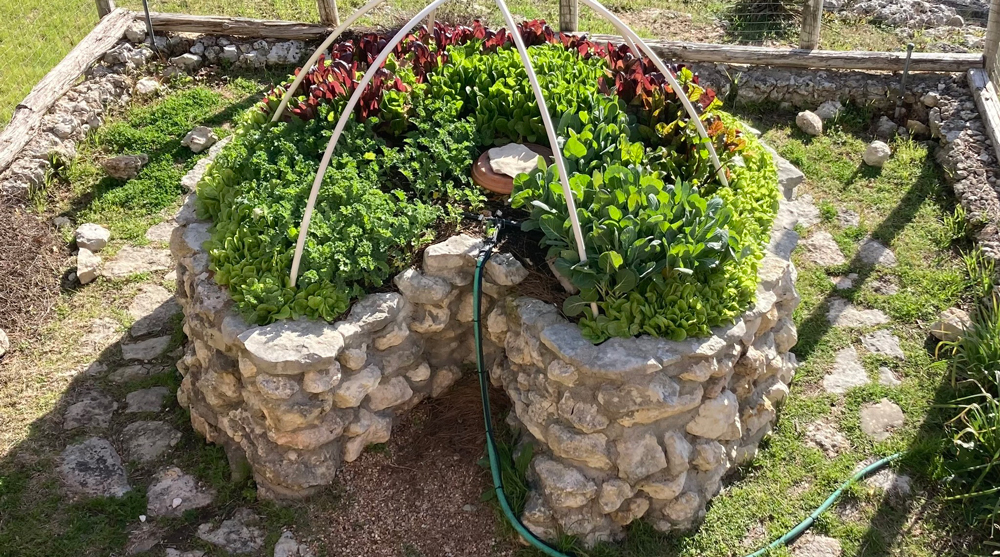
Keyhole gardening is a simple and smart way to grow vegetables, flowers, and herbs, especially if you want to save water and make the most of your space. Originally designed for areas with dry, tough climates, this type of garden is perfect for beginners who want a low-maintenance, eco-friendly way to get more from their garden. No matter if you're just starting out or have been gardening for a while, this guide will walk you through the basics of building and maintaining a keyhole garden.
What is Keyhole Gardening?
A keyhole garden is a raised circular garden bed with a compost basket in the center and a wedge-shaped pathway that allows easy access to the basket. The garden gets its name because, from above, the shape looks like a keyhole. The central basket is where you add kitchen scraps and water, which then helps feed your plants. The design makes it easy to reach all your plants, use less water, and grow more food in a smaller area.
How Does It Work?
The keyhole garden works by recycling nutrients. You add food scraps, leaves, and other organic materials into the central basket. As the compost breaks down, nutrients seep into the surrounding soil, giving your plants a steady food supply. Plus, the garden's raised design helps with water drainage and makes it easy to access without bending over too much. The keyhole-shaped pathway provides direct access to the compost basket, making it easy to maintain.
Materials You’ll Need:
- Outer Wall: You can use bricks, stones, or wooden planks to build the walls.
- Compost Basket: A cylinder made from wire mesh or chicken wire.
- Base Layer: Cardboard or newspaper to block weeds.
- Soil Layers: Start with branches and leaves, then top with good-quality soil mixed with compost.
How to Build a Keyhole Garden
Choose a Spot: Find a sunny spot that gets at least 6-8 hours of sunlight daily. Make sure it’s a level area and has good drainage.
Mark the Layout:
- Use a stake to mark the center of where your garden will go.
- Measure and cut a string to the desired diameter of your garden (usually 6-8 feet). Tie one end of the string to the stake and walk in a circle, marking the ground as you go. This will outline the garden’s shape.
- From the circle’s edge, mark a wedge-shaped notch (about 2 feet wide) that goes from the outside of the circle to the center. This is the path that allows access to the compost basket. The notch should be big enough for you to comfortably walk into the center of the garden to add compost.
Build the Outer Wall:
- Lay bricks, stones, or other materials along the marked circle, stacking them about 2-3 feet high to create the walls of your garden.
- Leave the wedge-shaped path open for easy access to the center of the garden, where the compost basket will be placed.
Install the Compost Basket:
- Place a wire mesh or chicken wire cylinder (about 1-foot in diameter) at the center of the garden. This will serve as the compost basket.
- Make sure the basket extends slightly above the walls so it’s easy to add compost and water.
Prepare the Base and Fill the Garden:
- At the bottom of the garden bed, lay cardboard or thick layers of newspaper to suppress weeds.
- Add a layer of twigs and branches for drainage, followed by grass clippings or leaves for organic matter.
- Finally, fill the bed with high-quality soil mixed with compost. The soil should slope gently downward from the compost basket towards the outer walls to help with water distribution.
Plant Your Garden:
- Arrange plants in concentric circles or rows, with taller plants near the center and shorter ones toward the outer edges.
- Planting this way ensures all plants get plenty of sunlight and benefit from the composting process.
What Can You Plant?
- Vegetables: Most veggies, besides indeterminate tomatoes and pole beans as they are too tall.
- Herbs: Basil, mint, and parsley are easy to grow and perfect for this garden.
- Flowers: almost any variety unless it's a climbing type or tall growing.
Tips for Success
- Keep Composting: Add kitchen scraps (but avoid meat, dairy, or oils) to your compost basket regularly.
- Use Mulch: Mulch around your plants to keep the soil moist and prevent weeds.
- Water Wisely: Pour water into the compost basket to let it trickle down and nourish your plants.
Why Try Keyhole Gardening?
- Saves Water: The design reduces water waste, perfect for areas with dry conditions.
- Recycles Kitchen Scraps: Turn waste into rich compost to feed your plants.
- Easy to Access: The raised bed and pathway are great for people with limited mobility.
- Low Maintenance: Once set up, it requires less weeding and watering.
Keyhole gardening is an easy, beginner-friendly way to grow your own food while being kind to the environment. Ready to give it a try?
































































































































































































































































































































































































































































































































































































































































